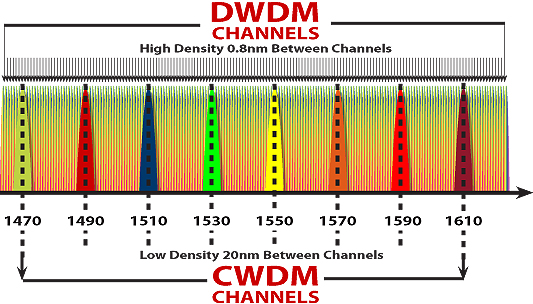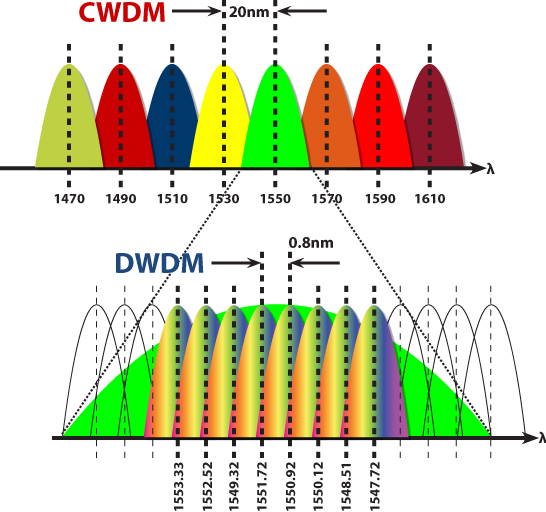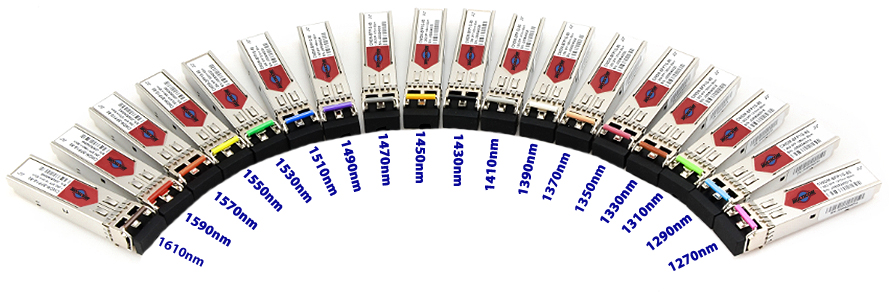Do Not Bury More Cable! Learn how a CWDM or DWDM can save you effort, time, and most of all, a lot of Money!
It can be easy to run more channels of higher bandwidth traffic over THE SAME FIBER! CWDM and DWDM are both effective methods to solve the increasing bandwidth capacity needs and maximize the utilization of both new and existing fiber.
Simply put, the need to bury more fiber is eliminated – among a host of other advantages. Use what you have for a lot more! And there are many other considerations and options available that can save massive amounts of capital and monthly costs.
So what are CWDM and DWDMs? And which should you use when?
Coarse Wavelength Division Multiplexing (CWDM) and Dense Wavelength Division Multiplexing (DWDM) are the two primary technologies developed based on Wavelength Division Multiplexing (WDM), but with different wavelength patterns and applications.

DWDMs pack in the channels by using narrow channel spacing – all over a single new or existing fiber
Though both CWDMs and DWDMs are effective methods to solve increasing bandwidth capacity needs, they are designed to tackle different network challenges.
To best understand how to decide which of these two WDM technologies may be the best option when planning a network, it’s best to have a basic understanding of how each technology works and what the differences are:
CWDM
- CWDM systems typically transport eight wavelengths with a channel spacing of 20nm in the spectrum grid from 1470nm to 1610nm – on a single fiber
- Lower total cost
- Lower complexity
- Lower power consumption
- Less complicated and lower cost lasers
- Can not be amplified
- Up to 80 km (~50 miles) reach
A CWDM system commonly supports eight wavelengths per fiber and is designed for short-range communications, using wide-range frequencies with wavelengths spread far apart (20nm).
Since CWDM is based on 20nm channel spacing in the 1470 to 1610nm spectrum, it is typically deployed on fiber spans up to 80km or less because optical amplifiers cannot be used with large spacing channels. This wide spacing of channels allows the use of moderately priced optics. However, the capacity of the links, as well as the distance supported, are less with CWDM than with DWDM. Generally, CWDM is used for lower cost, lower capacity (less than 10G), and shorter distance applications where cost is an important factor.
Note: In addition to the capability of supporting a greater number of wavelengths, CWDM and DWDM platforms are also capable of handling higher speed protocols as most optical transport equipment vendors today commonly support 100G or 200G per wavelength while emerging technologies are allowing for 400G and beyond.
DWDM
- DWDM systems can carry 40, 80, 96, or up to 160 wavelengths by utilizing a much narrower spacing 0.8/0.4nm (100 GHz/50 GHz grid) – on a single fiber
- Wavelengths are typically from 1525nm to 1565nm (C-band), with some systems also capable of utilizing wavelengths from 1570nm to 1610nm (L-band)
- Longer reach – up to 120 km (~75 miles)
- Higher density and bandwidth
- More accurate temperature-controlled lasers
- Dense spacing allows for amplification
In DWDM systems, the number of multiplexed channels is much denser than CWDM because DWDM uses tighter wavelength spacing to fit more channels onto a single fiber. Instead of the 20nm channel spacing used in CWDM (equivalent to approximately 15 million GHz), DWDM systems utilize a variety of specified channel spacing from 12.5 GHz to 200 GHz in the C-Band and sometimes the L-band.
Today’s DWDM systems typically support 96 channels spaced at 0.8nm apart within the 1550 nm C-Band spectrum (see graphic below). Because of this, DWDM systems can transmit a huge quantity of data through a single fiber link as they allow for many more wavelengths to be packed onto the same fiber.
DWDM is optimal for long-reach communications up to 120 km and beyond due to its ability to leverage optical amplifiers, which can cost-effectively amplify the entire 1550nm or C-band spectrum commonly used in DWDM applications. This overcomes long spans of attenuation or distance and when boosted by Erbium Doped-Fiber Amplifiers (EDFAs), DWDM systems have the capability to carry high amounts of data across long distances spanning up to hundreds or thousands of kilometers.

CWDMs utilize a channel spacing of 20nm, where a DWDMs utilize much denser spacing typically 0.8nm
CWDM or DWDM: Which should you use?
CWDM is a flexible technology that can be deployed to expand the capacity of a fiber network. It is a compact, cost-effective technology option when spectral efficiency or the need to span long distances under 80 km are not important requirements.
CWDM solutions, which typically utilize passive hardware components, are commonly deployed in point-to-point topology in enterprise networks and telecom access networks. For those reasons, CWDM is typically best suited for short-range applications that do not require services greater than 10Gb and in locations where not many channels are needed.
On the other hand, DWDM technology is the ideal solution for networks that require higher speeds, greater channel capacity, or for applications requiring the capability of utilizing amplifiers to transmit data across much longer distances. Though the hardware and electronics used in DWDM systems are not cheap, they are considerably more cost-effective than putting in new fiber.
Because of this, there is a growing demand to increase network capacity by utilizing DWDM optical networking applications to maximize the fiber connectivity between sites. Organizations are increasingly leveraging this technology as a scalable on-demand solution to keep up with their rising bandwidth demands.
Typically, DWDM systems utilize active hardware components and are often deployed as integrated hardware platforms such as ROADMs (Reconfigurable Optical Add-Drop Multiplexers), which provide enhanced operational capabilities and enable the creation of complex and scalable optical networks.
Because of its ability to handle so much data, DWDM is utilized by organizations spanning many industries as an integral part of their long-haul, core- or metropolitan-area fiber networks today. DWDM technologies are also used to interconnect data centers, such as ODCI (Optical Data Center Interconnect) platforms that provide ultra-high bandwidth links (400G and beyond) utilizing low-cost per bit hardware optimized for the data center environment.

Multicom stocks SFP/SFP+/XFPs for CWDM/DWDMs, and any type of network including GPON/XPON
Conclusion
We hope this article clarified the benefits, functionality, and advantages of CWDM and DWDMs. The main takeaway is that using the capabilities of CWDM and DWDMs, fiber optic cable is nearly limitless – that goes for existing cable as well as new deployments. Understanding this can save you time, effort, and most of all, a lot of money!
Multicom carries a wide variety of CWDM and DWDM components, as well as the DZS O-Series of environmentally hardened optical transport products that are optimized for high capacity and long-reach mobile backhaul scenarios.
Optical networking plays a key role in today’s multi-layer networks and is used to extend the reach of traditional pluggable optics, interconnect data centers and tie sites together within a campus or business park across metropolitan regions, between cities, or for long-haul national connectivity. As a result, public sector organizations, utilities, healthcare providers, financial institutions, corporate enterprises, and data center operators are considering optical transport to be the solution of choice for their mission-critical networks.
With the massive growth of over-the-top applications, cloud computing, mobile devices, and the need for consumers and employees to have constant access to their data and applications, CWDM and DWDM optical networking solutions are rapidly being adopted by businesses as their bandwidth and distance requirements continue to grow. Thus, many organizations across industries are now operating their own optical transport networks to consolidate high rates of bandwidth and different traffic types across long distances.
